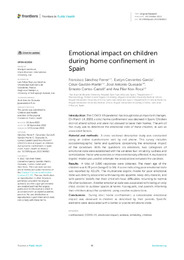Por favor, use este identificador para citar o enlazar este ítem:
https://hdl.handle.net/11000/30861Registro completo de metadatos
| Campo DC | Valor | Lengua/Idioma |
|---|---|---|
| dc.contributor.author | Sánchez-Ferrer, Francisco | - |
| dc.contributor.author | Cervantes-García, Evelyn | - |
| dc.contributor.author | Gavilán-Martín, César | - |
| dc.contributor.author | Quesada, José Antonio | - |
| dc.contributor.author | CORTÉS CASTELL, ERNESTO | - |
| dc.contributor.author | Nso-Roca, Ana Pilar | - |
| dc.contributor.other | Departamentos de la UMH::Farmacología, Pediatría y Química Orgánica | es_ES |
| dc.contributor.other | Departamentos de la UMH::Medicina Clínica | es_ES |
| dc.date.accessioned | 2024-01-31T10:51:40Z | - |
| dc.date.available | 2024-01-31T10:51:40Z | - |
| dc.date.created | 2022-10-14 | - |
| dc.identifier.citation | Frontiers in Public Health. Volume 10 - 2022 | es_ES |
| dc.identifier.issn | 2296-2565 | - |
| dc.identifier.uri | https://hdl.handle.net/11000/30861 | - |
| dc.description.abstract | Introduction: The COVID-19 pandemic has brought about important changes. On March 14, 2020, a strict home confinement was decreed in Spain. Children did not attend school and were not allowed to leave their homes. The aim of this study was to determine the emotional state of these children, as well as associated factors. Material and methods: A cross-sectional descriptive study was conducted using an online questionnaire sent by cell phone. This survey includes sociodemographic items and questions concerning the emotional impact of the lockdown. With the questions on emotions, two categories of emotional state were established with the variables fear, irritability, sadness and somatization: those who were less or more emotionally aected. A multivariate logistic model was used to estimate the associations between the variables. Results: A total of 3,890 responses were obtained. The mean age of the children was 6.78 years (range 0 to 16). A score indicating poor emotional state was reported by 40.12%. The multivariate logistic model for poor emotional state was directly associated with having less appetite, sleep disturbances, and with parents’ beliefs that their child will have di culties returning to normal life after lockdown. A better emotional state was associated with being an only child, access to outdoor spaces at home, having pets, and parents informing their children about the pandemic using creative explanations. Conclusions: During strict home confinement, a considerable emotional impact was observed in children as described by their parents. Specific elements were associated with a better or poorer emotional state | es_ES |
| dc.format | application/pdf | es_ES |
| dc.format.extent | 8 | es_ES |
| dc.language.iso | eng | es_ES |
| dc.publisher | frontiersin.org | es_ES |
| dc.rights | info:eu-repo/semantics/openAccess | es_ES |
| dc.rights | Attribution-NonCommercial-NoDerivatives 4.0 Internacional | * |
| dc.rights.uri | http://creativecommons.org/licenses/by-nc-nd/4.0/ | * |
| dc.subject | confinemen | es_ES |
| dc.subject | COVID-19 | es_ES |
| dc.subject | emotional impact | es_ES |
| dc.subject | sadness | es_ES |
| dc.subject | irritability | es_ES |
| dc.subject | children | es_ES |
| dc.title | Emotional impact on children during home confinement in Spain | es_ES |
| dc.type | info:eu-repo/semantics/article | es_ES |
| dc.relation.publisherversion | https://doi.org/10.3389/fpubh.2022.969922 | es_ES |

Ver/Abrir:
Emotional impact on children.pdf
201,95 kB
Adobe PDF
Compartir:
 La licencia se describe como: Atribución-NonComercial-NoDerivada 4.0 Internacional.
La licencia se describe como: Atribución-NonComercial-NoDerivada 4.0 Internacional.
.png)